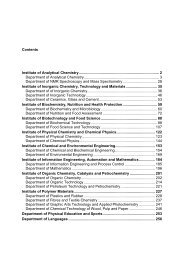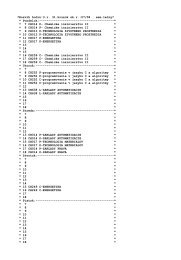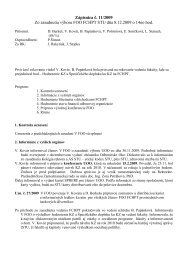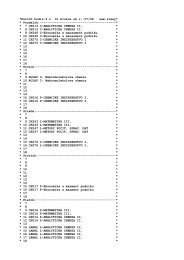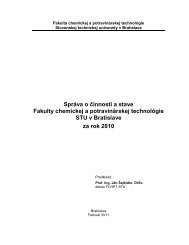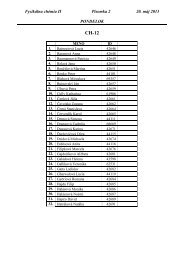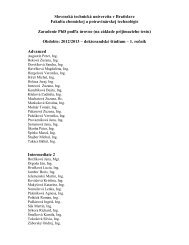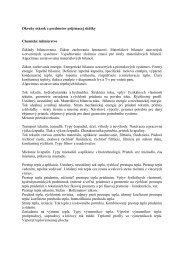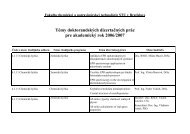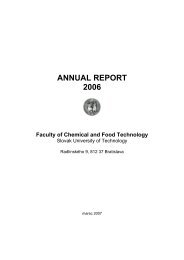rok 2007 - Fakulta chemickej a potravinárskej technológie
rok 2007 - Fakulta chemickej a potravinárskej technológie
rok 2007 - Fakulta chemickej a potravinárskej technológie
You also want an ePaper? Increase the reach of your titles
YUMPU automatically turns print PDFs into web optimized ePapers that Google loves.
IV. CURRENT RESEARCH PROJECTS<br />
VEGA Project No 1/2109/05 The Use of the Pulse Technique on the Preparation of the<br />
Composite and Alloy Layers on the Metal Substrates (Marta Chovancová)<br />
Ni-W alloy coatings were prepared on the steel substrate. The content of tungsten in coatings was<br />
increased with the growing current density and the corrosion resistance raised with the tungsten content as well.<br />
Annealed coatings showed better anticorrosion properties than the non-annealed ones.<br />
The preparation of electrochemical composite coatings with nickel matrix and PTFE dispersion particles has been<br />
studied and their mechanical properties has been evaluated.<br />
The participation of solid Fe powder particles in the transfer of charge through the heterogeneous system<br />
consisting of an electrolyte and conducting powder particles was studied by means of electrochemical impedance<br />
spectroscopy.<br />
The quality of coloured anodic oxidation layer of aluminium was analysed in dependence on alternative and pulse<br />
reverse current and used pigmentation electrolyte. The quality of the pigmentation is determined not only by the<br />
nickel content but the morphology of the deposited nickel as well.<br />
Project duration: from January 2005 to December <strong>2007</strong><br />
VEGA Project No 1/2108/05 The Chemical and Electrochemical Reactions of Sulphur Species<br />
at Aluminium Electrolysis (Pavel Fellner)<br />
The effect on the cathode and anode reactions when adding sodium sulphate to molten chlorides and fluorides<br />
was investigated by chronopotentiometry and cyclic voltammetry in the temperature range 820 °C – 1000 °C. The<br />
cathode process was explained under the assumption that Na 2 SO 4 thermally dissociates into Na 2 O and SO 3 ,<br />
which is the electroactive species. The formation of sulphide was observed. The influence of sulphide on<br />
aluminium electrolysis will be discussed. The anode reaction of sulphate depends on the electrode material. On<br />
gold electrodes, no electrochemical activity of sulphate was observed. However, when a platinum anode was<br />
used, sulphate was oxidized to oxygen and SO 3 that decomposed thermally. When a normal carbon anode was<br />
used, the presence of COS and SO 2 in the anode gas leaving the laboratory aluminium cell was observed.<br />
Adsorption of SO 2 on alumina used in the aluminium industry (so-called smelter-grade alumina) was studied in the<br />
temperature range 15 °C – 120 °C. The specific surface area of the smelter grade alumina was 88 m 2 /g. It was<br />
found that at temperatures lower than 40 °C, sulphur dioxide is bonded to alumina reversibly by physical forces,<br />
and the adsorption can be described satisfactorily by the Langmuir adsorption isotherm. The heat of adsorption<br />
was estimated to be –33 kJ.mol -1 .<br />
At temperatures in the range 80 °C – 120 °C, which prevail in dry scrubbers in the aluminium industry, the heat of<br />
adsorption was determined to be –56 kJ.mol -1 . When SO 2 was adsorbed at temperatures higher than 80 °C, about<br />
30 % of the SO 2 could not be desorbed when the samples were heated up to 250 °C. In the presence of SO 2 and<br />
oxygen, the formation of sulphate was determined at temperatures higher than 90 °C.<br />
Project duration: from January 2005 to December <strong>2007</strong><br />
VEGA Project No 1/2476/05 Ferrates– Thermodynamics and Kinetics of Chemical and<br />
Electrochemical Reactions in Molten Electrolyte and on the Phase Boundary Electrode -<br />
Electrolyte (Ján Híveš)<br />
The main aim of this project was to examine the possibility of the preparation and provide first information on the<br />
behaviour of the iron in a transpassive region of potentials in molten hydroxides environment.<br />
Electrochemical measurements (cyclic voltammetry and chronopotentiometry) were performed in eutectic mixture<br />
of NaOH-KOH. A maximum value of polarization potential in anodic way plays very important role in the ferrate<br />
(VI) formation. Increasing of potential does not result in production of higher amount of ferrate (VI) but competitive<br />
reaction (evolution of oxygen) is getting more intensive. In the beginning of the DC electrolysis process the high<br />
current efficiency (91%) is reached but quickly decreases in time of electrolysis down to 14% at the lower<br />
temperatures. Regarding the higher temperatures at the beginning of electrolysis is reached the current efficiency<br />
equal to 72%. Then with increasing time of electrolysis the current efficiency drops slowly down to the value of<br />
47% (3 h).<br />
Project duration: from January 2005 to December <strong>2007</strong><br />
41



